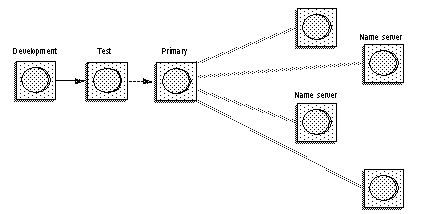Synchronization replicates application files and configuration information between servers. If you are using clusters, synchronization ensures that logical servers in a cluster share the same application files and configuration. Synchronization is also a useful alternative to importing and exporting packages.
For example, as Figure 6-2 illustrates, you can replicate new components from a testing or development server to one or more production servers. As long as you can connect to both servers, synchronization is quicker and easier than exporting and importing package files.
Figure 6-2: Synchronization example

If you are using clusters and make configuration changes to the primary server, the jagadmin user (or any user with the Admin role) can synchronize those changes to participating nonprimary servers.
To synchronize a cluster, you must be connected to the primary server for the cluster unless the primary server is down and cannot be restarted. In this case, you can connect to another server within the cluster and designate it as the new primary server.
You can use the synchronization option to move repository information between servers that are not part of a cluster. For example, you may want to move a development server’s repository to a test server. In this case, the synchronization command is similar to EAServer’s export/import options without the JAR file; instead of moving packages from one server to another, you are moving repository information.
Synchronization does not propagate deletions. If you delete an entity such as a component or Web application in the source installation, and you have previously replicated the entity by synchronization, you must connect to the target server with EAServer Manager or jagtool and delete the entity manually.
You can synchronize at the cluster, server, servlet, package, or component level. The level you choose determines the available synchronization options. Options that are not available are dimmed, and cannot be selected.
![]() Before you synchronize a cluster, shut down any services
that are running. If you do not, some files required for synchronization
may be locked.
Before you synchronize a cluster, shut down any services
that are running. If you do not, some files required for synchronization
may be locked.